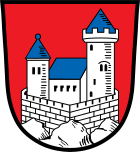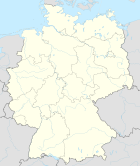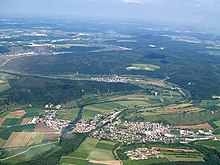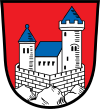Dollnstein
| coat of arms | Germany map | |
|---|---|---|

|
Coordinates: 48 ° 52 ' N , 11 ° 4' E |
|
| Basic data | ||
| State : | Bavaria | |
| Administrative region : | Upper Bavaria | |
| County : | Eichstatt | |
| Height : | 395 m above sea level NHN | |
| Area : | 40.51 km 2 | |
| Residents: | 2854 (Dec. 31, 2019) | |
| Population density : | 70 inhabitants per km 2 | |
| Postal code : | 91795 | |
| Area code : | 08422 | |
| License plate : | EGG | |
| Community key : | 09 1 76 121 | |
| Market structure: | 10 parish parts | |
Market administration address : |
Papst-Viktor-Str. 35 91795 Dollnstein |
|
| Website : | ||
| Mayor : | Wolfgang Roßkopf ( CSU ) | |
| Location of the Dollnstein market in the Eichstätt district | ||
Dollnstein ( Bavarian Doischda ) is a market in the west of the Upper Bavarian district of Eichstätt and is located in the Altmühltal Nature Park at the inlet of the Urdonautal to today's Altmühltal .
geography
Community structure
The municipality has 10 officially named parts of the municipality (the type of settlement is given in brackets ):
|
|
Neighboring communities
| Schernfeld | ||
| Mörnsheim |

|
Eichstatt |
| Wellheim | Nobility strike |
history
prehistory
A prehistoric and early historical settlement of the Dollnstein area has been proven in many ways, for example through finds that prove iron smelting in the Hallstatt period . The important Roman road ran through the municipality from Weißenburg (Großkastell, Markt) via Treuchtlingen, where there was a connection to the west, via Dollnstein with an Altmühlfurt or bridge, possibly there was also a connection to the Danube, further via Nassenfels (Markt, Administrative headquarters) to Großmehring / Pförring, where the Danube crossings were. Remains of a Villa Rustica were found in Dollnstein.
middle Ages
In the post-Roman period there was the border area between the Alemanni and Franconia (Sualafeld) in the west and Baiern (Nordgau) in the east. The first mention of Dollnstein as Tolunstein can be found in a deed of donation from Henry II to the Bergen monastery from the year 1007. However, archaeological evidence shows that it was fortified before 1000 AD. In 1139 a castle owned by the Counts of Grögling , who later became the Counts of Dollnstein, was mentioned by Hirschberg . Between 1305 and 1309 there were inheritance disputes between the diocese of Eichstätt and the Counts of Oettingen after the Hirschbergs died out. The House of Oettingen finally received Dollnstein and sold it to the Count of Heideck in 1360 .
In 1387 King Wenzel Dollnstein granted market rights . Before 1401 the market fortification was built and the market around the castle and church was rebuilt. Dollnstein's seal and coat of arms date from this period. In 1440 the place was sold to the Hochstift Eichstätt . At that time it was the largest market town in the territory. Dollnstein also exceeded half of the towns of the Hochstift Eichstätt around 1500 with 420 inhabitants, which from 1500 belonged to the Franconian Empire .
Modern times
During the witch hunt in the Eichstätt monastery , at least seven women from Dollnstein were accused of being witches and sentenced to death. Five of the executions took place in 1589 and 1590, and another in 1603 and 1625.
In 1870 Dollnstein received a railway connection.
Incorporations
On January 1, 1971, part of the Haunsfeld community (Ried and Groppenhof) was incorporated. On January 1, 1972, the former communities of Breitenfurt and Eberswang followed. Obereichstätt was added on May 1, 1978.
Population development
Between 1988 and 2018 the market grew from 2,595 to 2,867 by 272 inhabitants or by 10.5%.
politics
Municipal council
The Dollnstein municipal council has 14 members. In the local elections on March 15, 2020 , the voter turnout was 74.45%:
mayor
Wolfgang Roßkopf (CSU) has been mayor since May 2014. He was elected with 56.4% of the vote and confirmed in office on March 15, 2020 with 79.0% for a further six years. His predecessor was Hans Harrer, who was in office for 12 years (2002–2014).
coat of arms
| Blazon : "In red on three silver stone blocks, a silver castle with a curtain wall, keep and blue roofs on the buildings." | |
Culture and sights
Attractions
In addition to Dollnstein Castle , in whose stables the Altmühlzentrum is located, the largely preserved city wall, which was built at the end of the 14th century, is worth seeing .
The parish church of St. Peter and Paul is elevated on a rock bank within the walled market town. The core of the nave of the church is Romanesque ( consecrated in 1063), the choir was built in the Gothic style (around 1300), as was the tower, which was given a baroque helmet after a fire in 1728 based on plans by Gabriel de Gabrieli . Gabrieli also built the castle-like rectory next to the church (1744). The nave was extended to the west in 1842 and the side aisles in 1931/32. The most outstanding work of art in the church are the frescoes in the choir, which were created around 1320 to 1330 and were rediscovered and restored in 1877/78. The frescoes begin on the left with the depiction of Christ as the Man of Sorrows and two Church Doctors , followed by a cycle of apostles running around the choir , who show the twelve articles of the creed on banners . Half-figures of prophets with texts from the Holy Scriptures are attached above . The end of the row of frescoes on the right side is the representation of two church teachers and the Mother of God , who is surrounded by a golden halo (so-called Mandorla Madonna ). Further depictions of Mary are a late Gothic wooden figure (around 1470 - 1480) on the left in front of the choir arch and a late Gothic Pieta (around 1490) in front of the war memorial . On the right side altar - also a treasure of the church - there is a picture of the Last Supper, which was created around 1520-1530 and is probably attributed to the Nördlingen painter Hans Schäufelein , a colleague of Dürer in his Nuremberg workshop. Numerous epitaphs of prince-bishop officials in the church point to Dollnstein's past as an administrative district of the prince-bishopric of Eichstätt; Particularly noteworthy is the grave monument of the caretaker of Werdenstein († 1735), presumably by the court sculptor Matthias Seybold , and the epitaph of Kastnerin Sausenhofer († 1704), probably a work by Christian Handschuher .
The old town area with a medieval structure, partly from the 12th, partly from the 14th century, has several individual monuments in the typical architectural style of the Jura house .
A 22-tonne cube sculpture by Alf Lechner has stood at the entrance to the Obereichstätt district since 2019 . It is a permanent loan from the Alf Lechner Foundation, which also took over the costs.
Architectural monuments
Natural monuments
The rock formations along the Altmühltal , the Beixenhard natural forest reserve, several dry grasslands and juniper heaths around Dollnstein and the Burgstein opposite the Bubenrother Mühle, which is one of the 100 most beautiful geotopes in Bavaria, are scenic .
Economy and Infrastructure
Dollnstein is designated as a small center (catchment area about 7500 inhabitants, of which about 1550 in the village, 3000 in the community) and offers a corresponding basic service.
Companies
There are several smaller companies in the metal and mechanical engineering sector in Dollnstein. The Rohrdorfer Group produces precast concrete parts in Dollnstein. Until 2003 the last German production site of the luxury fashion company Escada was in the village .
tourism
On September 21, 2011, the eight municipalities of Dollnstein, Wellheim , Nassenfels , Egweil , Oberhausen , Burgheim , Rennertshofen and Neuburg an der Donau formed the ARGE Urdonautal , a working group whose purpose is to promote and coordinate tourism in the Urdonautal .
traffic

Dollnstein has had a stop on the Munich - Ingolstadt - Treuchtlingen - Nuremberg route since 1870 (stop for all RB and RE ). The area around Dollnstein is popular with railway photographers because of the charming landscape and the historic railway systems. In the district of Obereichstätt there was also a breakpoint that was closed in 1985. The Dollnstein – Rennertshofen railway was shut down in 1993 and dismantled in the following years. The cycle path, which connects the Altmühl cycle path from Dollnstein with the Danube cycle path near Rennertshofen, leads partly over the route of the former railway line.
The middle center of Eichstätt is only about 15 kilometers away, to the southeast the upper center of Ingolstadt is about 45 kilometers.
Personalities
Honorary citizen
- Ludwig Körner (1915–2012), Catholic pastor, first dean of the Eichstätt deanery, honorary citizen of Dollnstein and holder of the citizen's medal in gold in Sengenthal
sons and daughters of the town
- Ludwig Ruff (1878–1934), architect
- Erich Zenger (1939–2010), professor for the Old Testament at the University of Münster
- Walther L. Bernecker (* 1947), historian and philologist, specialist in Spain and Latin America
- Gisela Schneeberger (* 1948), cabaret artist and actress
Personalities associated with Dollnstein
- Philipp von Arenberg (1848-1906); Prince from the noble house of Arenberg , later cathedral capitular in Eichstätt, was chaplain in Dollnstein from 1880 to 1882
- Alf Lechner (1925-2017); Artist (steel sculptor); lived in Obereichstätt; Atelier in the former ironworks in Obereichstätt, connected with its own sculpture park
literature
- Dollnstein 600 years of market. Nature, culture, history, the present. Kipfenberg, Hercynia 1987.
- The Jura House 13/2007 , Eichstätt.
- Johann Kaspar Bundschuh : Dollnstein . In: Geographical Statistical-Topographical Lexicon of Franconia . tape 1 : A-egg . Verlag der Stettinische Buchhandlung, Ulm 1799, DNB 790364298 , OCLC 833753073 , Sp. 625-628 ( digitized version ).
- Pleikard Joseph Stumpf : Dollnstein . In: Bavaria: a geographical-statistical-historical handbook of the kingdom; for the Bavarian people . Second part. Munich 1853, p. 704 ( digitized version ).
Web links
Individual evidence
- ↑ "Data 2" sheet, Statistical Report A1200C 202041 Population of the municipalities, districts and administrative districts 1st quarter 2020 (population based on the 2011 census) ( help ).
- ↑ Mayor. Dollnstein community, accessed on June 9, 2020 .
- ^ Community Dollnstein in the local database of the Bayerische Landesbibliothek Online . Bavarian State Library, accessed on September 14, 2019.
- ^ Wilhelm Volkert (ed.): Handbook of Bavarian offices, communities and courts 1799–1980 . CH Beck, Munich 1983, ISBN 3-406-09669-7 , p. 456 .
- ^ Federal Statistical Office (ed.): Historical municipality directory for the Federal Republic of Germany. Name, border and key number changes in municipalities, counties and administrative districts from May 27, 1970 to December 31, 1982 . W. Kohlhammer, Stuttgart / Mainz 1983, ISBN 3-17-003263-1 , p. 599 .
- ↑ Candidates and results - district Eichstätt, Dollnstein. In: Wahl.info. Donaukurier / PNP, March 15, 2020, accessed on August 24, 2020 .
- ↑ Entry on the Dollnstein coat of arms in the database of the House of Bavarian History
- ^ Zecherle, Karl: Dollnstein. In: Churches and monasteries in the district of Eichstätt, published by the district of Eichstätt, 1983, p. 12
- ↑ Big moment for a small town , Eichstätter Kurier from December 19, 2019; Accessed December 19, 2019
- ↑ The lights are off in the Escada factory in Dollnstein , at www.donaukurier.de , accessed on August 4, 2018
- ^ Ludwig Körner passed away , neumarktonline.de, December 31, 2012













